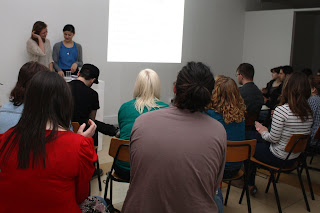Friday, 24 February 2012
Tuesday, 21 February 2012
StAnza Preview Event
Wednesday, 15 February 2012
Symbols and Symbolism Seminar
REWIND Screening Event
REWIND Screening Event
Friday, 3 February 2012
Reflecting on Research: DRU Dialogues
Design Research Unit 1942-72: DRU Dialogues
Jo Bletcher: PhD Research in Design at DJCAD
Back in December, I ventured into the Cooper Gallery for my first public outing as a ‘Research Student’. With the blessings of Sophia and Laura, I set myself up within the space, to encourage conversations with visitors, and gain a deeper insight into the practices of the Design Research Unit. DRU Dialogues was an early research exercise, evaluating curatorial practice in terms of ‘curating innovation’, in relation to the exhibition ‘Design Research Unit 1942-72’, a touring exhibition curated my Michelle Cotton. I used my time in the gallery to take notes, sketch, take photographs, create mind maps, and read more about the origins and working methods of the DRU. Michelle Cotton’s book that accompanied the exhibition is an account of the history of the DRU and its members, from the end of the 1920s up until the 1970s. It contextualizes the objects that were shown at the exhibition, to a greater depth than was possible within the limits of the exhibition space.
The main benefit to creating a research space within the gallery was the possibility of approaching visitors, and hearing their thoughts and opinions. I think it is important to be able to access the superb facilities we have here. Creating a conversational space: having the opportunity to use the gallery, as a site for research and interaction, was hugely beneficial for my continuing development as a researcher. A collaborative approach to learning and development is encouraged throughout DJCAD: Exhibitions already work with a student curatorial team, who last year produced exhibitions such as Collections Part 1 and Part 2. Throughout the remainder of my time as a researcher, I hope to be able to work again with Exhibitions, as well as staff and students from other departments.
During DRU Dialogues, students, staff and members of the public all visited the exhibition, for various reasons and durations. Several comments made by visitors related to their pleasure at seeing a design exhibition within the Cooper Gallery. As a space predominantly used for fine art practices, the situating of design here was significant, and an act that curator Sophia would look to repeat. Original photographs, letterheads and physical objects, were other aspects that were of major interest to some viewers, and these went some way to developing a narrative of the historical period in which the DRU were active.
For me, the discussions that arose around curating and viewing design, and how this seems to differ from curating and viewing fine art, were significant. Do you require more, or less explanation of design works in a gallery space? Does your approach to interpreting design differ from interpreting ‘art’? What is the essence of design, the product or the designer’s processes? How do you convey the research process, through exhibition, in an engaging, relevant way for the viewer? Is using the term ‘viewer’ or ‘audience’ too passive for exhibitions that encourage an engagement with design processes? These are questions that will be cropping up again and again throughout my research, and I hope to continue the conversations that attempt to address them, and produce responses to them. No final solutions were forthcoming during DRU Dialogues, so the conversation will have to continue…

























